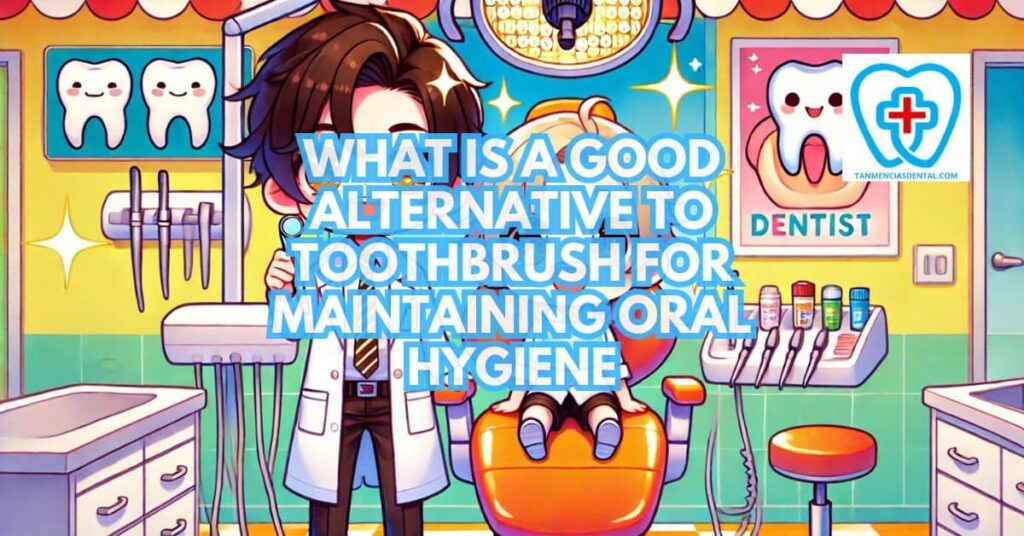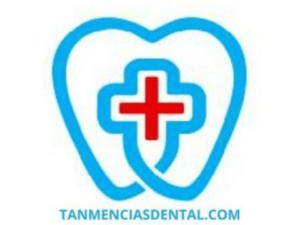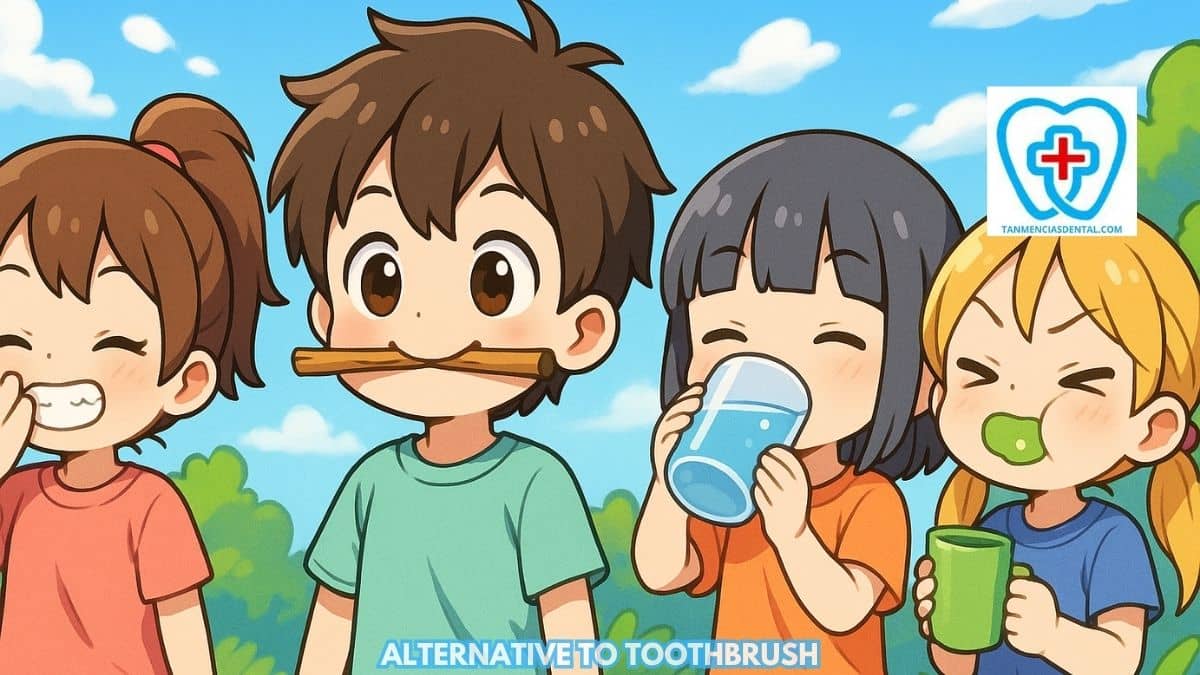Keeping your mouth clean is important for good health, but sometimes a toothbrush is not available.
In these cases, finding a good alternative to toothbrush can help you care for your teeth and gums.
Many people turn to simple methods like chewing sticks, saltwater rinses, or oil pulling when brushing is not possible.
Others use modern tools such as water flossers and mouthwash to keep their mouths clean and fresh.
We’ll explore these options and explain how each one can support oral hygiene when a toothbrush is out of reach.
1. The Importance of Oral Hygiene Beyond the Toothbrush
Good oral hygiene means more than just brushing; it includes habits and tools that keep the mouth healthy in many ways.
Even without a toothbrush, proper teeth cleaning is possible using safe and simple methods that remove food and plaque.
A small amount of baking soda mixed with water can gently scrub the teeth and neutralize acids that harm enamel.
When no tools are available, a person can use a clean cloth or even their index finger wrapped in tissue to wipe food from the tooth surfaces.
This simple action can help reduce bacteria buildup and keep the mouth fresher until normal brushing is possible.
People with sensitive gums or limited mobility may also benefit from these gentle cleaning methods.
Maintaining good oral hygiene without a toothbrush requires creativity and awareness of everyday materials that can safely clean teeth.
Including rinsing with water or a mild solution after meals adds another layer of protection for oral health.
By learning alternative ways of teeth cleaning, anyone can keep their mouth clean and healthy even when a toothbrush is not available.
🦷 How Organic Toothbrushes Contribute to a Sustainable Oral Care Routine
2. Chew Sticks: An Ancient Alternative to Toothbrush
Long before modern dental tools were invented, people used chew sticks made from aromatic tree twigs to clean their teeth.
These natural tools are still used in various parts of the world, offering a simple and biodegradable alternative to toothbrushes and toothpaste.
Chew sticks, when frayed at one end, act as a brush and toothpick combo to remove food debris and plaque effectively.
The natural antibacterial properties of certain tree twigs, such as neem or miswak, also promote oral health by reducing harmful bacteria.
Adopting chew sticks as a part of a dental care routine can connect us with ancient practices, emphasizing sustainability and natural health.
🦷 Can You Brush Your Teeth With Dentures In?
3. Dental Floss: Keeping the Gaps Clean
Dental floss is indispensable in achieving a comprehensive oral hygiene routine, targeting the crevices and gaps that toothbrushes often overlook.
Its precise action helps to dislodge and remove food particles and plaque that accumulate between teeth, areas that are critically vulnerable to bacteria that cause gum disease and bad breath.
By incorporating regular flossing into your daily dental care, you ensure a deeper clean, safeguarding the health of your tooth enamel, which is essential for preventing cavities and maintaining overall tooth strength.
While not an alternative to brushing your teeth, flossing acts as a vital complement, enhancing the effectiveness of your oral hygiene efforts and helping to keep your teeth and gums in optimal condition.
For those with narrow gaps between their teeth, dental floss proves even more beneficial, offering a cleaning efficiency that toothbrushes simply cannot match.
Moreover, the consistent use of dental floss contributes significantly to the long-term health and durability of both teeth and gums, preventing conditions that can lead to tooth loss and more serious health issues.
Making a habit of flossing is a key step in preserving not just oral health but your overall well-being, ensuring that your smile remains bright and healthy for years to come.
🦷 How Long to Wait After Brushing Teeth to Use White Strips?
4. Water Flossers: A Modern Teeth-Cleaning Tool
Water flossers have emerged as a powerful ally in the quest for comprehensive oral hygiene, offering a user-friendly and effective alternative to traditional flossing.
By using a high-pressure stream of water to clean between teeth and along the gum line, water flossers can remove trapped food particles and plaque that toothbrushes may miss.
This method is particularly beneficial for individuals with braces, dental implants, or those who find traditional flossing difficult or uncomfortable.
Water flossers also massage the gums, promoting blood circulation and gum health.
Incorporating a water flosser into your dental routine can enhance your oral hygiene, providing a thorough clean in a gentle, efficient manner.
🦷 How to Choose the Best Toothpaste to Whiten Teeth with Braces

5. Mouthwash: An Auxiliary Tool for Oral Hygiene
Mouthwash serves as a valuable supplement in the dental care regimen, offering benefits that extend beyond fresh breath.
With properties that can kill bacteria and reduce plaque, mouthwash reaches areas that brushing and flossing might not, such as the back of the throat and deep between teeth.
Using mouthwash can also strengthen enamel if it contains fluoride, providing an extra layer of protection against tooth decay.
However, it’s important to use mouthwash as an adjunct to, not a replacement for, brushing and flossing to ensure comprehensive oral care.
Regular use of mouthwash can elevate your oral hygiene routine, supporting a healthier mouth and gums.
🦷 Is It Normal for Your Teeth to Wiggle with Braces?
6. Warm Saltwater Rinse: A Simple Way to Clean and Soothe Your Mouth
A warm saltwater rinse is an easy and natural way to keep your mouth clean when a toothbrush or mouthwash is not available.
Mixing half a teaspoon of salt into one cup of warm water creates a gentle solution that helps kill some bacteria and loosen food particles.
Swishing it in your mouth for about thirty seconds can calm sore gums and reduce minor swelling.
This method is also helpful for soothing small mouth cuts or irritation after dental work.
Although useful, it should not replace daily brushing and should be used only as a temporary cleaning method.
🦷 Hate Brushing Teeth? The Daily Struggle is Real
7. Oil Pulling: A Traditional Method for Teeth and Gums
Oil pulling, a practice originating from Ayurvedic medicine, involves swishing a tablespoon of oil, typically coconut, sesame, or sunflower, in the mouth for about 15 to 20 minutes.
This method is believed to draw out toxins from the body, improve oral health by reducing bacteria, and freshen breath.
While scientific evidence on oil pulling is still evolving, many who practice it report healthier gums, whiter teeth, and a decrease in plaque buildup.
It’s a natural, chemical-free approach to dental care that can serve as a supplementary practice to traditional oral hygiene methods.
However, oil pulling should not replace brushing and flossing, but rather act as an additional measure for those interested in natural health remedies.
🦷 Why Poor Brushing With Braces Can Lead to Serious Dental Problems
8. Interdental Brushes: An Alternative for Teeth Without a Toothbrush
Interdental brushes offer a practical solution for cleaning spaces where a toothbrush might not reach, such as between wide-spaced teeth, around braces, and under bridges.
These small brushes are designed to remove plaque and food particles from between the teeth, reducing the risk of gum disease and tooth decay.
Interdental brushing can be particularly beneficial for individuals with orthodontic appliances, as it helps maintain oral hygiene in hard-to-reach areas.
They come in various sizes to fit different space widths, making them a versatile tool in oral care routines.
Incorporating interdental brushes into daily dental care provides a thorough clean and can significantly contribute to the health of your teeth and gums.
🦷 Is Coconut Oil Good to Brush Your Teeth With?
9. Diet Choices: How What You Eat Affects Your Oral Health
The connection between what you eat and your oral health is strong, as food choices can either protect or harm your teeth.
Eating crunchy fruits and vegetables, like apples and carrots, helps clean the teeth and increase saliva, which washes away food particles.
Whole grains, nuts, and dairy products also strengthen tooth enamel by providing calcium and other important nutrients.
On the other hand, foods high in sugar or acid can wear down enamel and lead to cavities if eaten too often.
Chewing sugar-free chewing gum after meals can help clean the mouth by boosting saliva flow and neutralizing acids.
Some foods, such as strawberries or certain dairy items, may gently aid in tooth whitening, although brushing is still needed for the best results.
Choosing foods that protect teeth and limiting sugary snacks can greatly improve long-term oral health and keep your smile bright.
🦷 Why Orthodontic Toothbrushes Are Essential During Orthodontic Treatment
10. Regular Dental Checkups: Why You Should Visit Your Dentist
Visiting the dentist regularly is paramount for early detection and treatment of oral health issues before they escalate into more serious conditions.
Dentists not only provide professional cleanings that remove plaque and tartar buildup but also offer valuable advice tailored to individual oral health needs.
These checkups can also identify potential problems that may not be visible or painful yet, preventing future complications.
Regular dental visits are essential, even for those who use alternatives to toothbrushes and toothpaste, ensuring a comprehensive approach to oral care.
Staying proactive with dental appointments can save time, money, and discomfort in the long run by maintaining optimal oral health.
🦷 Best Foods for Gingivitis: Fight Gum Disease Naturally
11. Understanding the Limitations of Toothbrush Alternatives
Understanding the limitations of toothbrush alternatives is crucial for anyone looking to diversify their oral hygiene routine.
While certain methods can help clean your teeth in the absence of a traditional toothbrush, they may not always reach the effectiveness of fluoride toothpaste in combating plaque and preventing tooth decay.
For example, using your finger with a bit of toothpaste can offer a temporary solution to brush your teeth, but it lacks the precision and thoroughness of bristles for cleaning hard-to-reach areas.
Furthermore, some natural remedies promise to whiten and clean teeth, yet they might not provide the comprehensive care that prevents dental diseases over the long term.
Therefore, it’s essential to view these alternatives as complements rather than complete substitutes for traditional brushing.
Consulting with dental professionals can provide insight into how these methods fit into your personal oral health routine, ensuring you don’t compromise on dental care.
While embracing alternative methods, recognizing their limitations will guide you toward a balanced and effective oral hygiene strategy that suits your specific needs.
🦷 Basic Dental Needs in Marikina
12. Tongue Scraping: An Easy Method for Fresh Breath and Better Oral Health
Tongue scraping is a straightforward method that can greatly improve your dental hygiene.
This practice involves gently scraping the surface of your tongue to remove bacteria, food particles, and dead cells.
These substances can cause bad breath and negatively impact your overall oral health if not removed.
Regular tongue scraping can lead to fresher breath and a cleaner mouth, complementing your regular teeth-cleaning routine.
Incorporating this habit into your daily dental hygiene regimen supports your overall oral care and contributes to maintaining regular dental health.
By reducing the bacteria on your tongue, you can also lower the risk of cavities and gum disease.
Tongue scraping is a simple addition to your dental care routine that can have significant benefits for your oral health.
🦷 Experienced Dental Professionals in Marikina
👨⚕️ Conclusion
Integrating alternatives to toothbrush and toothpaste into your oral hygiene routine can offer additional ways to maintain dental health, especially in unique or challenging circumstances.
These alternatives, from ancient practices like oil pulling to modern tools like water flossers, enrich our dental care options.
However, they should complement traditional methods rather than replace them entirely, with regular brushing, flossing, and dental checkups remaining as the foundation of oral hygiene.
Personal preferences, lifestyle, and specific dental needs will guide the choice of alternatives, making each oral care journey unique.
Embracing a holistic approach to dental health, one that combines traditional and alternative practices, can lead to a healthier mouth and a brighter smile.
😊 Self-Promotion
At Tan-Mencias Dental Clinic, nestled in the heart of Parang, Marikina City, we’re committed to providing you with top-notch dental care in a comfortable and welcoming environment.
Our team of friendly professionals is eager to address all your dental needs and questions, ensuring your visit is as informative and pleasant as possible.
For your convenience, you can reach out to us in several ways: give us a call at 0917-145-1074, leave a message on our Facebook page, or use the contact form on our website.
We’re here to make your dental health journey a positive and stress-free experience.
Come and discover the difference at Tan-Mencias Dental Clinic, where your smile is our top priority!
❔ FAQs
1. What can I use if I do not have a toothbrush?
If you do not have a toothbrush, you can clean your teeth using a clean cloth, paper towel, or your finger wrapped in tissue.
Chewing sticks, such as miswak or neem, and warm saltwater rinses can also help remove food particles and bacteria.
These methods work best as temporary options until you can brush normally again.
2. Is a warm saltwater rinse safe for daily use?
A warm saltwater rinse is safe to use for a few days, especially after dental work or when you have gum irritation.
However, it should not replace brushing and flossing.
Using it too often may dry out your mouth or affect the natural balance of bacteria, so use it only when needed.
3. Can oil pulling replace brushing my teeth?
No, oil pulling should not replace brushing or flossing.
It can help reduce bacteria, freshen breath, and support gum health, but it does not remove plaque as effectively as a toothbrush.
Dentists recommend using oil pulling only as an extra step, not a substitute for brushing.
4. Are chew sticks like miswak as effective as toothbrushes?
Chew sticks can clean teeth well when used correctly, especially those from trees with natural antibacterial properties like neem or miswak.
They help remove plaque and freshen breath.
Still, modern toothbrushes clean more thoroughly, so chew sticks are best used as a natural alternative when a brush is unavailable.
5. How can I keep my mouth clean while traveling without a toothbrush?
When traveling, you can use mouthwash, sugar-free gum, or a warm saltwater rinse to keep your mouth clean.
Wiping your teeth with a clean cloth or using a disposable finger brush also helps remove food buildup.
Always rinse with water after meals to wash away food particles until you can brush again.

